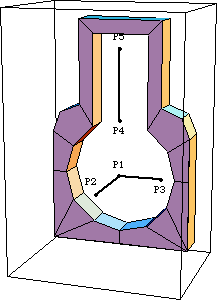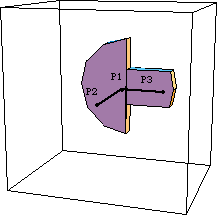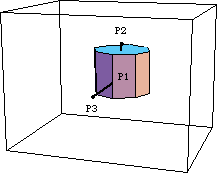1.3.2 3D BodiesGroundThe local coordinate system of the ground body originates at the center of the crankshaft. Five local point coordinates are used on the ground body.
P1 and P2 are two points that define the rotational axis of the crankshaft. P1 is at the global origin and P2 is on the positive Z axis.
P3 is a point on the positive X axis that is used (with point 1) to define a reference line to control the rotation of the crankshaft and the piston.
P4 and P5 are two points on the positive Y axis that are used to define the vertical translation line of the piston.Here is a graphic of the ground body. The point coordinates on the ground body are P1 {0, 0, 0}, P2 {0, 0, 5}, P3 {3, 0, 0}, P4 {0, 4, 0}, and P5 {0, 9, 0}.

CrankshaftThe local coordinate system of the crankshaft originates at its rotational center. Three local point coordinates are used on the crankshaft.
P1 and P2 are two points that define the rotational axis of the crankshaft. P1 is on the local origin and P2 is on the positive local z axis.
P3 is a point on the local x axis that is used as the attachment point of the connecting rod and as a reference point to control the rotation of the crank.Here is a graphic of the crankshaft. The local point coordinates on the crankshaft are P1 {0, 0, 0}, P2 {0, 0, 5}, and P3 {3, 0, 0}.

PistonThe local coordinate system on the piston originates at a point that is four units below the attachment point of the connecting rod. Thus, when the slider-crank mechanism is in its initial configuration, the local origin of the piston is coincident with the global origin. Three local point coordinates are used on the piston.
P1 is a point on the local y axis that is the attachment point of the connecting rod.
P2 is another point on the local y axis that is the other end of the translation line of the piston.Here is a graphic of the piston. The local point coordinates on the piston are P1 {0, 4, 0}, P2 {0, 6, 0}, and P3 {0, 4, 5}.

|